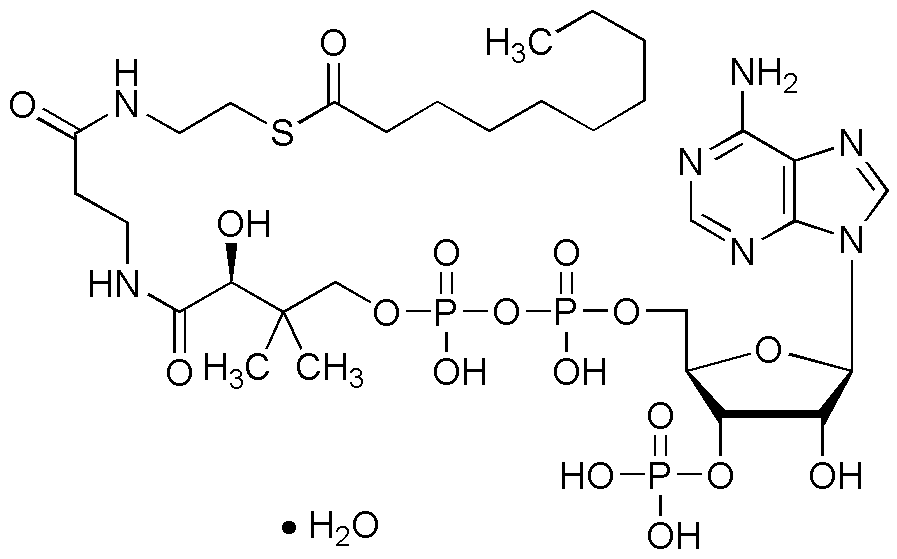Decanoyl coenzyme A monohydrate is widely utilized in research focused on:
- Metabolic Studies: This compound plays a crucial role in fatty acid metabolism, making it essential for researchers studying energy production and lipid biosynthesis in cells.
- Biochemical Pathways: It is used to investigate various biochemical pathways, particularly in the context of enzyme activity and regulation, helping scientists understand cellular processes better.
- Drug Development: In pharmaceutical research, it aids in the design and testing of new drugs targeting metabolic disorders, providing insights into how drugs interact with metabolic enzymes.
- Food Industry Applications: The compound is also explored for its potential in food technology, particularly in flavor enhancement and preservation, due to its fatty acid properties.
- Biotechnology: It is utilized in the development of biosensors and biocatalysts, which can improve the efficiency of biochemical reactions in industrial processes.
Información general
Propiedades
Seguridad y normativas
Aplicaciones
Decanoyl coenzyme A monohydrate is widely utilized in research focused on:
- Metabolic Studies: This compound plays a crucial role in fatty acid metabolism, making it essential for researchers studying energy production and lipid biosynthesis in cells.
- Biochemical Pathways: It is used to investigate various biochemical pathways, particularly in the context of enzyme activity and regulation, helping scientists understand cellular processes better.
- Drug Development: In pharmaceutical research, it aids in the design and testing of new drugs targeting metabolic disorders, providing insights into how drugs interact with metabolic enzymes.
- Food Industry Applications: The compound is also explored for its potential in food technology, particularly in flavor enhancement and preservation, due to its fatty acid properties.
- Biotechnology: It is utilized in the development of biosensors and biocatalysts, which can improve the efficiency of biochemical reactions in industrial processes.
Documentos
Hojas de datos de seguridad (HDS)
La SDS proporciona información de seguridad completa sobre la manipulación, el almacenamiento y la eliminación del producto.
Especificación del producto (PS)
La PS proporciona un desglose completo de las propiedades del producto, incluida la composición química, el estado físico, la pureza y los requisitos de almacenamiento. También detalla los rangos de calidad aceptables y las aplicaciones previstas del producto.
Certificados de análisis (COA)
Busque certificados de análisis (COA) ingresando el número de lote del producto. Los números de lote y de partida se pueden encontrar en la etiqueta de un producto después de las palabras "Lote" o "Lote".
Número de catálogo
Número de lote/lote
Certificados de origen (COO)
Este certificado de origen confirma el país en el que se fabricó el producto y también detalla los materiales y componentes utilizados en él y si se deriva de fuentes naturales, sintéticas u otras fuentes específicas. Este certificado puede ser necesario para cumplir con las normativas aduaneras, comerciales y regulatorias.
Número de catálogo
Número de lote/lote
Hojas de datos de seguridad (HDS)
La SDS proporciona información de seguridad completa sobre la manipulación, el almacenamiento y la eliminación del producto.
DownloadEspecificación del producto (PS)
La PS proporciona un desglose completo de las propiedades del producto, incluida la composición química, el estado físico, la pureza y los requisitos de almacenamiento. También detalla los rangos de calidad aceptables y las aplicaciones previstas del producto.
DownloadCertificados de análisis (COA)
Busque certificados de análisis (COA) ingresando el número de lote del producto. Los números de lote y de partida se pueden encontrar en la etiqueta de un producto después de las palabras "Lote" o "Lote".
Número de catálogo
Número de lote/lote
Certificados de origen (COO)
Este certificado de origen confirma el país en el que se fabricó el producto y también detalla los materiales y componentes utilizados en él y si se deriva de fuentes naturales, sintéticas u otras fuentes específicas. Este certificado puede ser necesario para cumplir con las normativas aduaneras, comerciales y regulatorias.


